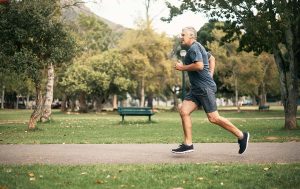Cardio vs. Strength Training to Increase Testosterone
Posted: April 2, 2024
Excess weight is a direct contributor to low testosterone levels in men. Regular exercise can help combat this issue. Both cardiovascular exercise and strength training can support increased testosterone production; however, strength training typically yields a more substantial boost in testosterone levels, especially if you are already undergoing TRT treatment. A balanced fitness plan should include both cardio for heart health and strength training for optimal hormonal benefits.
If you’re concerned about low T, the Low T Center can help. We offer Testosterone Replacement Therapy (TRT) to increase your testosterone levels. We also have resources to support your weight loss goals and improve your overall health. Schedule an initial health assessment with us to jumpstart your health journey.
Strength Training and Testosterone
Weightlifting and resistance training are the most effective when it comes to boosting testosterone levels, particularly for short-term spikes right after a workout. When you challenge your muscles with heavy weights or resistance bands, microscopic tears occur in the muscle fibers. Your body goes into repair mode, triggering a cascade of hormonal responses. Testosterone plays a crucial role in this process. It helps ramp up protein synthesis, the building blocks needed to repair and strengthen those damaged muscle fibers.
This surge in testosterone production is the body’s natural way to optimize muscle recovery and growth, leading to the short-term testosterone boost you experience after a weightlifting or resistance training session.
Cardio Reduces Body Fat to Support Testosterone Production
Excess weight and low testosterone are interlocked in a cycle. Being overweight causes your testosterone to drop, while low testosterone levels can cause you to gain weight more quickly, especially around your midsection.
Fat cells contain an enzyme called aromatase, which converts testosterone into estrogen. The more excess fat you have, the more estrogen conversion takes place, leading to a decline in testosterone levels. This hormonal imbalance can contribute to further weight gain and a host of other health problems.
Cardiovascular exercise helps reduce body fat. Since excess body fat can lower testosterone levels, cardio plays a role in improving overall hormonal balance in conjunction with strength training for supporting healthy testosterone production.
Try HIIT Workouts for Optimal Results
When it comes to boosting testosterone levels, workout intensity matters. High-intensity workouts with short rest intervals tend to deliver a bigger punch in terms of testosterone response. This applies to both strength training and HIIT (High-Intensity Interval Training) cardio formats.
Intense workouts push your body to its limits, creating a greater demand for muscle repair and recovery, thus stimulating testosterone production. Compound exercises, such as squats, deadlifts, and bench presses, are superstars for maximizing testosterone response due to their recruitment of multiple muscle groups simultaneously.
To further optimize testosterone increases, focus on moderate to heavy weights that challenge your muscles and aim for a high workout volume – this means more sets and repetitions for each exercise. By combining intensity, compound movements, and workout volume, you can optimize the testosterone-boosting benefits of your workouts.
Note that it is important to consult with your doctor before beginning a new high-intensity exercise program, especially if you have any underlying health conditions.
Exercise May Not be Enough – You May Need TRT
While exercise is essential for overall health and can help with testosterone levels, it might not be enough to fully address your low testosterone.
If you experience low testosterone symptoms like fatigue, low libido, or mood changes, it’s important to consult a healthcare provider experienced in hormone management like Low T Center. Our team can assess your hormone levels and determine if Testosterone Replacement Therapy (TRT) is the right solution for you. TRT, combined with a healthy lifestyle, can effectively restore testosterone levels and improve your quality of life.
Support TRT and Exercise with Healthy Lifestyle Choices
Testosterone Replacement Therapy (TRT) and exercise work best when supported by healthy lifestyle choices. These choices promote overall hormonal health and maximize the benefits of your workouts. Here are key areas to focus on:
- Healthy Sleep: Aim for 7-8 hours of quality sleep each night. Sleep deprivation disrupts hormonal balance.
- Nutrition and Food Choices: Prioritize whole foods like fruits, vegetables, lean protein, and healthy fats. Limit processed foods, sugar, and excessive alcohol.
- Stress Management: Find healthy ways to manage stress, such as exercise, meditation, or spending time in nature. Chronic stress can lower testosterone.
Effective Low Testosterone Treatment Plans
Consistency is key when it comes to reaping the testosterone-boosting benefits of exercise. Regular workouts are necessary to maintain those gains. Strength training stimulates testosterone production, but the effects are often short-term. Consistent workouts keep those levels elevated over time.
Importantly, everyone is different. Your body’s response to exercise can vary based on factors like genetics, age, and your current fitness level. Some individuals may experience a more significant boost in testosterone than others.
Consult with the healthcare professionals at Low T Center about boosting your testosterone levels with TRT to support your exercise regime. Get your personalized TRT treatment plan now so you can see greater improvements in energy levels, muscle mass, and overall well-being.
Related Posts
Disclaimer: This article is made available for general, entertainment and educational purposes only. The opinions expressed herein do not necessarily reflect those of Low T Center. You should always seek the advice of a licensed healthcare professional.


